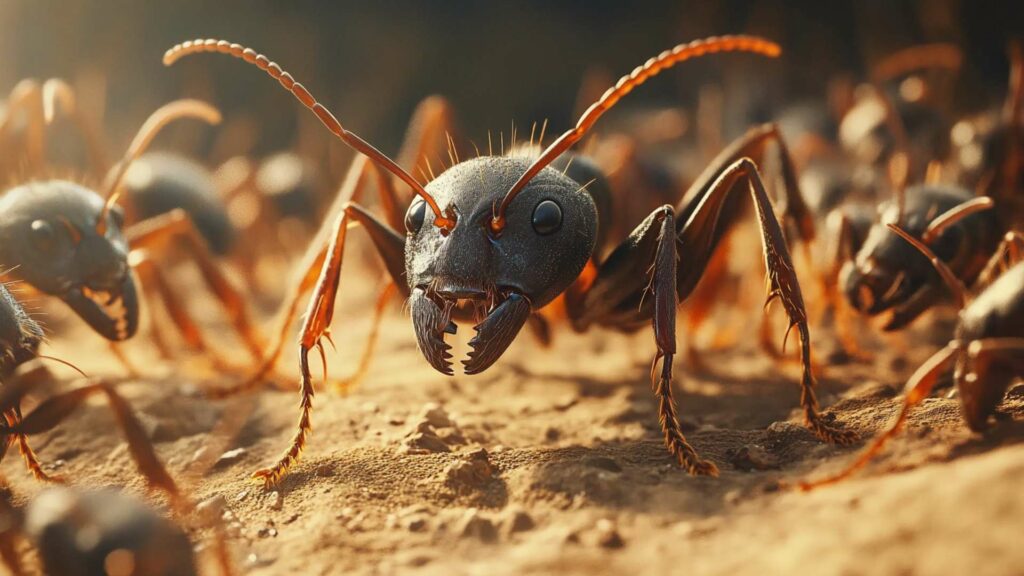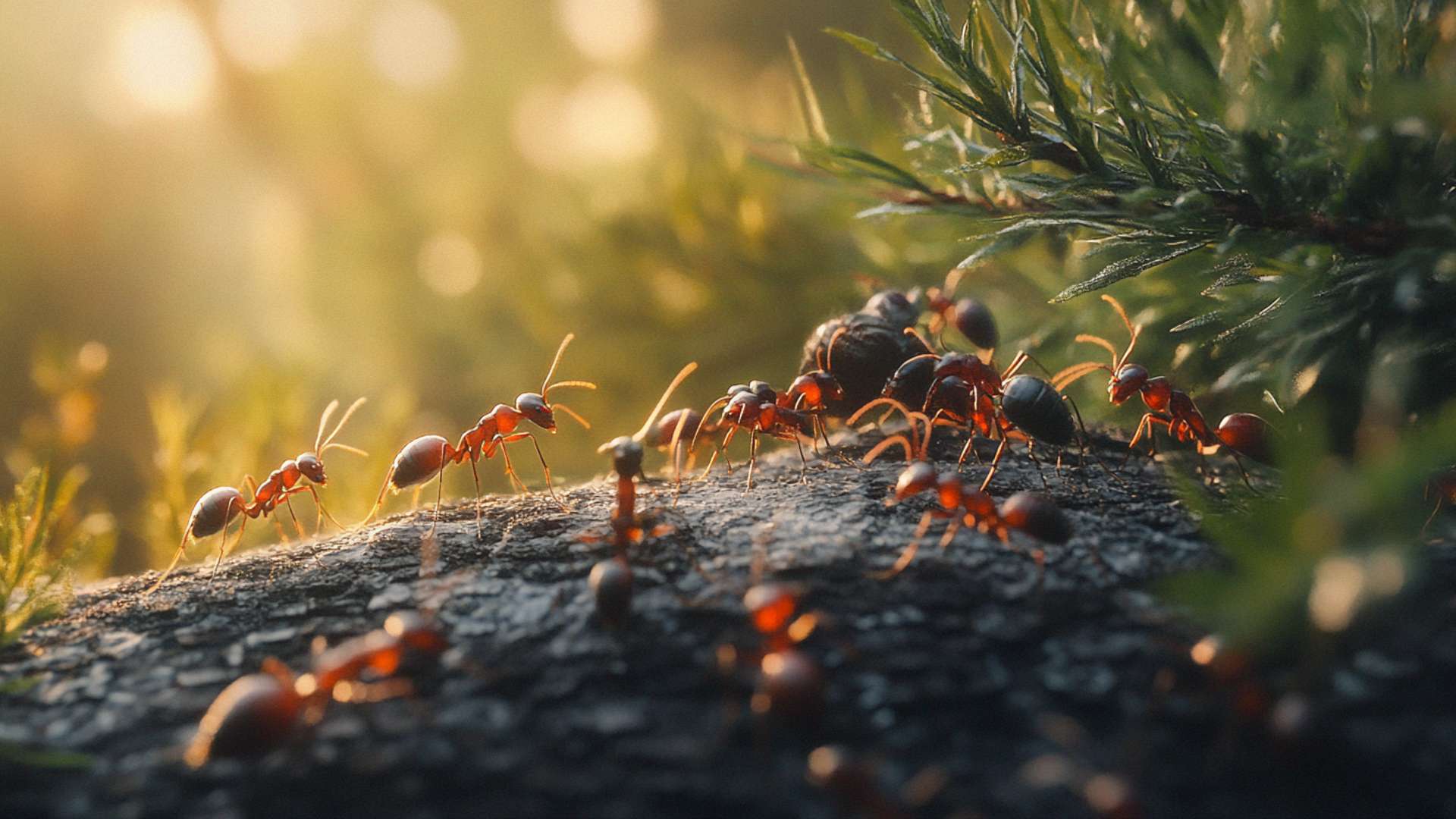Ants, those industrious little creatures that scurry about meticulously, have captivated human curiosity for centuries. With over 12,000 known species and an estimated population of quadrillions worldwide, ants dominate almost every terrestrial habitat on Earth. These tiny insects with their complex social structures and impressive abilities continue to astound scientists and nature enthusiasts alike.
Ant colonies are remarkable microcosms of organized labor, cooperation, and communication. Each ant has a specific role within the colony – from workers that forage for food to soldiers that protect the nest.
Intricate chemical trails guide their movements while sophisticated pheromone signals allow them to coordinate tasks efficiently. Witnessing the unwavering determination of an ant carrying a load many times its own weight is enough to inspire awe in anyone.
Common misconception: Do ants sting or bite?

When it comes to the topic of ants and their defense mechanisms, one common question arises: do ants have fire ant sting, or do ants bite? The answer is not as straightforward as it may seem.
Ants possess both biting mandibles and stingers on their bodies, but not all species utilize both methods of defense. The confusion arises because many people use the terms “sting” and “bite” interchangeably.
However, there are distinct differences between the two actions. Biting involves using sharp mandibles to grip onto something or chew it.
On fire ant bite on the other hand, stinging refers to injecting venom through a specialized structure called a stinger. It’s important to note that not all ants have stingers capable of delivering venomous bites or stings that can cause pain or allergic reactions in humans.
Some fire ant stings and bites may be irritating but relatively harmless, while others can pack quite a punch and require medical attention if an individual has an allergy or experiences severe symptoms. So now let’s embark on a journey into the intriguing realm of ants and explore their biting and stinging abilities in greater detail.
Understanding Ants’ Defense Mechanisms
An Overview of Ant Anatomy and Behavior
Ants, small but mighty, inhabit nearly every corner of our planet. These tiny creatures belong to the insect family Formicidae and are known for their complex societal structures and efficient division of labor. To understand their defense mechanisms, it is crucial to delve into their anatomy and behavior.
Ants possess a segmented body consisting of a head, thorax, and abdomen. Their bodies are covered in an exoskeleton made of chitin, providing protection against external threats.
Headed by a pair of strong mandibles, ants use these appendages for various tasks such as carrying food or defending themselves. In terms of behavior, ants exhibit remarkable communication skills through pheromones.
These chemical signals allow them to coordinate activities within the colony efficiently. Additionally, ants have different castes: workers that gather food and build nests; soldiers that defend the colony from invaders; and reproductive males and females that ensure the species’ continuity.
Differentiating Between Stinging and Biting
When it comes to ant defense mechanisms, two primary modes stand out: stinging and biting. Understanding the distinction between these actions is crucial in determining how best to handle encounters with these industrious insects.
Stinging is primarily associated with certain ant species injecting venom into their victims using a specialized structure called the stinger located at the posterior end of their abdomen. The venom injected typically contains formic acid—a compound responsible for inducing pain or irritation at the ant sting’ site.
On the other hand, biting involves ants using their mandibles as formidable weapons to clamp down on potential threats or prey. Unlike stinging, bites from ants do not inject venom but can still cause discomfort or pain due to powerful jaw muscles exerting pressure.
Differentiating between ant bites or an ant bite or stings can be vital in assessing the potential risks associated with encounters. While most ant bites or stings result in mild symptoms such as redness, itching, or localized swelling, some venomous ants, like the imported fire ants from South America, can cause more serious reactions.
In rare cases, individuals with severe allergies may experience life-threatening anaphylactic reactions requiring immediate medical attention. By understanding these distinctions and being aware of individual sensitivities to ant bites or insect stings, appropriate measures can be taken to mitigate any potential health risks.
Stinging Ants: The Formic Acid Arsenal
Sting Anatomy and Venom Injection Process
When it comes to the fascinating world of ants, their defense mechanisms are a testament to their survival skills. While some may wonder whether ants sting or whether ant bite or sting you, the truth is that they can do both, depending on the species and situation. Stinging ants, in particular, wield a formidable weapon in the form of formic acid-filled stingers.
The anatomy of an ant’s sting is quite intriguing. At the rear end of an ant’s body lies a specialized abdominal structure called an acidopore.
This is where venomous formic acid is produced and stored. When an ant feels threatened or perceives danger, it instinctively uses its powerful muscles to contract its abdomen and forcefully inject formic acid through the stinger into its target.
Notable Species with Potent Stings: Bullet Ants and Fire Ants

Among the many species of stinging ants worldwide, there are two notorious culprits that stand out for their potent stings: bullet ants (Paraponera clavata) and fire ants (Solenopsis spp.). Bullet and black fire ants, also known as “the kings of pain,” inhabit tropical regions such as South America. These intimidating insects possess one of nature’s most excruciatingly painful stings.
Victims often describe it as feeling like being shot by a bullet hence their name! Peer-reviewed studies have shown that bullet ant venom contains various toxins that cause intense pain lasting up to 24 hours.
Fire ant stings, these red ants are another species notorious for delivering painful stings in swarms. Found in warmer regions around the world, including parts of North America, red fire ants (Solenopsis invicta) have become infamous for infesting areas and causing discomfort with their bites or stings.
Their venom contains alkaloids that cause a burning sensation, with burning pain often resulting in raised, itchy welts on the skin. Fire ants are relentless attackers and their swarming behavior can lead to multiple stings, especially if fire ants bite or their nest is disturbed.
Stinging ants possess an impressive formic acid arsenal that they use to defend themselves and their colonies. The anatomy of most ants and their bite or sting allows for efficient venom injection, making their bites or stings formidable.
Notably, bullet ants and fire ants showcase the power of venom with painful stings that can leave lasting discomfort. So next time you encounter these tiny yet mighty creatures, remember to exercise caution and avoid provoking their wrath.
Biting Ants: Powerful Mandibles at Work

Mandible Structure and Function in Biting
Ants, those industrious little creatures, have evolved an impressive array of defensive mechanisms. While some ants rely on venomous stings, others have developed strong mandibles to inflict biting attacks.
The mandibles are the jaw-like structures situated at the front of an ant’s head. These powerful appendages serve multiple purposes, including capturing prey, defending their colonies, and even manipulating objects within their environments.
The structure of ant mandibles varies across species based on their specific needs. Generally, the mandibles consist of two opposing parts that can move horizontally or vertically to deliver a bite.
The tips are often sharp and serrated, allowing them to penetrate the exoskeleton or skin of their victims. In some cases, these mouthparts are also used for grooming tasks and digging tunnels.
Noteworthy Species Known for Their Bites (Army Ants & Trap-Jaw Ants)
Among the biting ants known for their aggressive behavior are army ants and trap-jaw ants – both fascinating examples of nature’s ingenuity in the realm of predatory insects. Army ants are notorious cooperative biters found primarily in tropical regions. They live in massive colonies and possess one common goal: locating food sources to sustain their voracious appetites.
When they stumble upon prey—small animals like insects or even reptiles—thousands of worker ants launch coordinated attacks by using their powerful jaws to bite simultaneously. This collective force overwhelms and subdues larger organisms that venture too close to female ants in their territory.
On the other hand, trap-jaw ants are renowned for their lightning-fast jaws that snap shut on unsuspecting victims with incredible speed and force. These remarkable insects possess specialized trigger hairs on their heads that help them sense approaching prey or threats accurately.
Once triggered, their mandibles snap shut exceptionally fast, often catapulting the ants into the air. Trap-jaw ants primarily use this mechanism for hunting, but they can also employ it defensively.
Biting ants have evolved mandibles to effectively capture prey and protect their colonies. Army ants exhibit cooperative behavior and utilize their powerful jaws as a collective force to overpower larger creatures.
Meanwhile, trap-jaw ants have developed lightning-fast jaws that spring shut with remarkable speed, enabling them to secure prey or defend themselves from potential threats. The world of biting ants is one filled with remarkable adaptations and survival strategies that continue to awe and captivate entomologists and curious observers alike.
Lesser-Known Ant Species and Their Defense Tactics
Weaver ants: Unique ability to spray formic acid from their abdomens

In the vast world of ants, some species possess defense mechanisms that are truly astonishing. One such species is the weaver ant, known for its unique ability to spray formic acid from its abdomen as a means of defense. Weaver ants are found in tropical regions across the globe and are renowned for their intricate nests made by weaving leaves together using silk produced by their larvae.
But it’s not just their impressive nest-building skills that make weaver ants stand out; they have evolved a remarkable method of defense. When threatened or provoked, these resourceful insects can contract their abdominal muscles and forcefully expel a stream of formic acid towards the intruder.
Formic acid is a corrosive substance that can cause irritation and pain upon contact with the skin or eyes. This defensive tactic serves as both a deterrent and an offensive mechanism for weaver ants.
By spraying formic acid, they can ward off predators while also mobilizing an attack against potential threats to their colony. It’s an awe-inspiring adaptation that showcases the ingenuity of nature’s creations.
Bulldog ants: Aggressive biters with venomous bites that cause severe pain

While some ant species rely on stinging or spraying formic acid, others have evolved powerful jaws capable of delivering venomous bites. Bulldog ants, predominantly found in Australia, belong to this category and are notorious for being extremely aggressive when defending themselves or their territory.
These ferocious insects possess sharp mandibles specifically designed for biting rather than cutting or chewing like most other ant species. When threatened, bulldog ants will clamp down with tremendous force using their mandibles, injecting venom into their victim through small openings called puncture sites.
The venom contains toxins that target the nervous system, resulting in intense pain and inflammation. The bites of bulldog ants can cause severe reactions in humans, especially those who are allergic or have a heightened sensitivity to venomous insects.
Symptoms may include localized swelling, redness, and excruciating pain. In some cases, individuals may even experience chest pain or a drop in blood pressure.
It is crucial to exercise caution when encountering bulldog ants to prevent ant bites and avoid their painful bites. If bitten, prompt medical attention should be sought, particularly if there is a history of severe allergic reactions to ant bites and stings.
Immediate first aid measures such as cold compresses on the sting or bite site can help alleviate some discomfort while awaiting professional medical care. The world of ants never ceases to amaze with its diverse array of defense mechanisms.
Weaver ants demonstrate their ability to spray formic acid as a potent deterrent against threats, while bulldog ants employ their formidable jaws and venomous bites to protect their colonies fiercely. The adaptability and resourcefulness exhibited by these lesser-known ant species provide a fascinating insight into the intricate workings of nature’s creations.
Unusual Cases and Curiosities
Acacia Ant-Plant Mutualism: How Acacia Trees Provide Homes for Stinging Ant ColoniesWhen it comes to fascinating interactions in the natural world, the relationship between acacia trees and stinging ant colonies stands out. In what can only be described as a mutually beneficial partnership, certain species of acacia trees create specialized structures called “domatia” to provide shelter for stinging ants. Within the domatia, these tiny warriors establish their colonies, forming an impressive defense force that protects the tree from herbivorous animals or competing plants. In return for this safe haven, the acacia tree offers essential sustenance to its little guardians in the form of food bodies rich in lipids and proteins. The remarkable aspect of this mutualism is that the tree benefits not just from physical protection but also from chemical warfare. The stinging ants release formic acid when they detect any potential threat to their home – be it an encroaching plant or a grazing animal. This acidic secretion acts as a deterrent, effectively warding off trespassers and maintaining a peaceful coexistence between the acacia tree and its loyal ant protectors.
Zombie-Ant Fungus: Fungal Infection Manipulating Ant BehaviorNature has its fair share of peculiar phenomena, and one particularly eerie occurrence involves a fungal parasite known as Ophiocordyceps unilateralis that infects certain ant species, effectively turning them into zombies. This mind-controlling fungus targets ants in tropical rainforests, making them unwitting victims caught in a macabre cycle. Once infected by spores released by the fungus, ants become manipulated into climbing vegetation and latching onto a leaf’s underside with their mandibles firmly affixed—a death grip orchestrated by fungal mind control. As days pass, the fungus grows and consumes the ant’s body, eventually sprouting a spore-bearing stalk from the ant’s head, ready to release more sinister spores to infect new victims. The precise mechanisms behind this phenomenon are still being studied, but one thing is clear: Ophiocordyceps unilateralis has evolved a highly effective strategy to ensure its own survival by exploiting ants’ nervous systems and compelling them to serve as unwitting hosts for fungal reproduction. It serves as a haunting reminder of nature’s ability to manipulate even the most intricate behaviors for its own mysterious purposes. The natural world never ceases to amaze us with its intricacies and curiosities. From acacia trees providing sanctuary for stinging ant colonies in exchange for protection and chemical warfare, to zombie-ant fungi that manipulate their hosts’ behavior for their own sinister reproductive needs—the interactions between ants and their surroundings offer endless fascination. These unusual cases remind us that there is much more beneath the surface when pondering whether ants sting or bite. Nature’s innovative strategies continue to astonish us, revealing complex relationships that enrich our understanding of the world around us.
Conclusion
Appreciating the Complexity of Ant Defense Mechanisms
Throughout this exploration of ant behavior and anatomy, it becomes clear that ants possess a fascinating array of defense mechanisms. From stinging to biting, these tiny creatures have developed sophisticated adaptations to protect themselves and their colonies.
Understanding the complexity of ant defense mechanisms not only deepens our appreciation for the intricate world of insects but also underscores the importance of coexisting with nature’s diverse inhabitants. Ants have evolved over millions of years to be effective defenders, utilizing venomous stings or powerful mandibles depending on their species and circumstances.
The intricate structure and function of their body parts play a crucial role in ensuring survival in a world full of predators and competitors. By appreciating this complexity, we gain insight into the remarkable adaptability and tenacity of these industrious creatures.
Final Thoughts on the Age-Old Question – Do They Sting or Bite?
So, do ants sting or bite? The answer lies within the diversity found bee sting and across ant species.
While some ants possess venomous stingers capable of delivering a painful sting multiple times, others rely on their strong mandibles to deliver bites that can inflict intense pain. It is important to note that not all ants are aggressive towards humans unless provoked or if their colony is threatened.
In encounters with ants in everyday life, it is crucial to exercise caution and respect for these tiny but mighty creatures. In case one experiences an even severe allergic reaction to insect bites or stings from ants, it is advisable to clean the affected area with mild soap and water, apply a cool compress to alleviate swelling if necessary and monitor for any adverse reactions.
However, severe reactions should be treated immediately by seeking medical attention. As we conclude our journey into understanding whether ants sting or bite humans, let us marvel a few hours at the intricate workings of nature’s smallest defenders.
These remarkable insects remind us that even the tiniest among us can possess remarkable survival strategies. By coexisting peacefully with ants and all creatures around us, we contribute to the delicate balance of our ecosystem, ensuring a harmonious and interconnected world for generations to come.
Deter Ants with D-Termination: Las Vegas’ Leading Pest Control Service!

If you’re dealing with ant problems, D-Termination is here to provide a solution. Our experienced team excels at discouraging ants, revitalizing cleanliness, and preserving the integrity of your surroundings. Bid farewell to ants—opt for D-Termination for effective pest control today!
Reach out to us at 702-919-6310 or visit dtermination.com to schedule your ant control service and regain your space from these unwanted pests.
Frequently Asked Questions:
House ants generally bite; they don’t sting.
Certain species, like fire ants, are known for their stinging.
Black ants typically bite; they are not known for stinging.
The main difference is that ant bites result from mandibles, while ant stings involve a venomous stinger.








